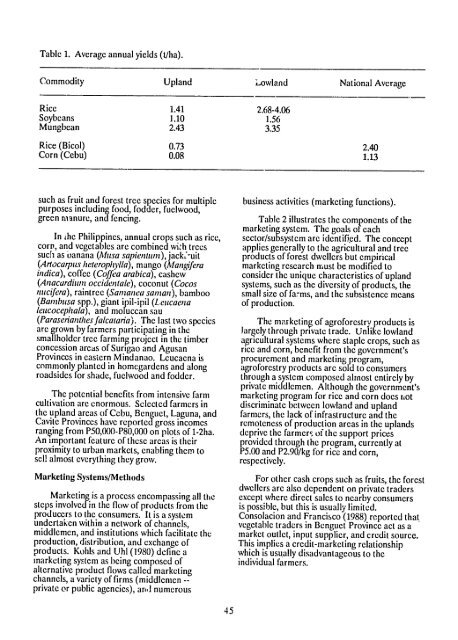multipurpose tree species research for small farms: strategies ... - part
multipurpose tree species research for small farms: strategies ... - part
multipurpose tree species research for small farms: strategies ... - part
Create successful ePaper yourself
Turn your PDF publications into a flip-book with our unique Google optimized e-Paper software.
Table 1. Average annual yields (t/ha).<br />
Commodity Upland<br />
Rice 1.41<br />
Soybeans<br />
Mungbean<br />
1.10<br />
2.43<br />
Rice (Bicol) 0.73<br />
Corn (Cebu) 0.08<br />
such as fruit and <strong>for</strong>est <strong>tree</strong> <strong>species</strong> <strong>for</strong> multiple<br />
purposes including food, fodder, fuclwood,<br />
green manure, and fencing.<br />
In the Philippines, annual crops such as rice,<br />
coro, and vegetables are combined with <strong>tree</strong>s<br />
such as banana (Musasapientuni), jack,-uit<br />
(Anocarpitsheterophylla), mango (Mangifera<br />
indica), coffee (Coffea arabica),cashew<br />
(Anacardiutmoccidentale), coconut (Cocos<br />
nucifera), rain<strong>tree</strong> (Samanea saman), bamboo<br />
(Bambusa spp.), giant ipil-ipil (Letucaena<br />
leucocephala), and moluccan sau<br />
(Paraserianthesfalcataria).The last two <strong>species</strong><br />
are grown by farmers <strong>part</strong>icipating in the<br />
<strong>small</strong>holder <strong>tree</strong> farming project in the timber<br />
concession areas of Surigao and Agusan<br />
Provinces in eastern Mindanao. Lcucaena is<br />
commonly planted in homegardens and along<br />
roadsides <strong>for</strong> shade, fuelwood and fodder.<br />
The potential benefits from intensive farm<br />
cultivation are enormous. Selected farmers in<br />
the upland areas of Cebu, Ben uet, Laguna, and<br />
Cavite Provinces have reported gross incomes<br />
ranging from P50,000-P80,000 on plots of 1-2ha.<br />
An important feature of these areas is their<br />
proximity to urban markets, enabling them to<br />
sell almost everything they grow.<br />
Marketing Systems/Methods<br />
Marketing is a process encompassing all the<br />
steps involved in the flow of products from the<br />
producers to the consumers. It is a system<br />
undertaken within a network of channels,<br />
middlemen, and institutions which facilitate the<br />
production, distribution, and exchange of<br />
products. Kohls and Uhl (1980) define a<br />
marketing system as being composed of<br />
alternative product flows called marketing<br />
channels, a variety of firms (middlemen -private<br />
or public agencies), an.] numerous<br />
45<br />
Lowland National Average<br />
2.68-4.06<br />
1.56<br />
3.35<br />
2.40<br />
1.13<br />
business activities (marketing functions).<br />
Table 2 illustrates the cornponents of the<br />
marketing system. The goals of each<br />
sector/subsystem are identified. The concept<br />
applies generally to the agricultural and <strong>tree</strong><br />
products of <strong>for</strong>est dwellers but empirical<br />
marketing <strong>research</strong> must be modified to<br />
consider the unique characteristics of upland<br />
systems, such as the diversity of products, the<br />
<strong>small</strong> size of <strong>farms</strong>, and the subsistence means<br />
of production.<br />
The marketin of agro<strong>for</strong>estry products is<br />
largely through private trade. Unlike lowland<br />
agricultural systems where staple crops, such as<br />
rice and corn, benefit from the government's<br />
procurement and marketing program,<br />
agro<strong>for</strong>estry products are sold to consumers<br />
through a system composed almost entirely by<br />
private middlemen. Although the government's<br />
marketing program <strong>for</strong> rice and corn does iot<br />
discriminate between lowland and upland<br />
farmers, the lack of infrastructure and the<br />
remoteness of production areas in the uplands<br />
deprive the farmers of the support prices<br />
provided through the program, currently at<br />
P5.00 and P2.90/kg <strong>for</strong> rice and corn,<br />
respectively.<br />
For other cash crops such as fruits, the <strong>for</strong>est<br />
dwellers are also dependent on private traders<br />
except where direct sales to nearby consumers<br />
is possible, but this isusually limited.<br />
Consolacion and Francisco (1988) reported that<br />
vegetable traders in Benguet Province act as a<br />
market outlet, input supplier, and credit source.<br />
This implies a credit-marketing relationship<br />
which isusually disadvantageous to the<br />
individual farmers.

















